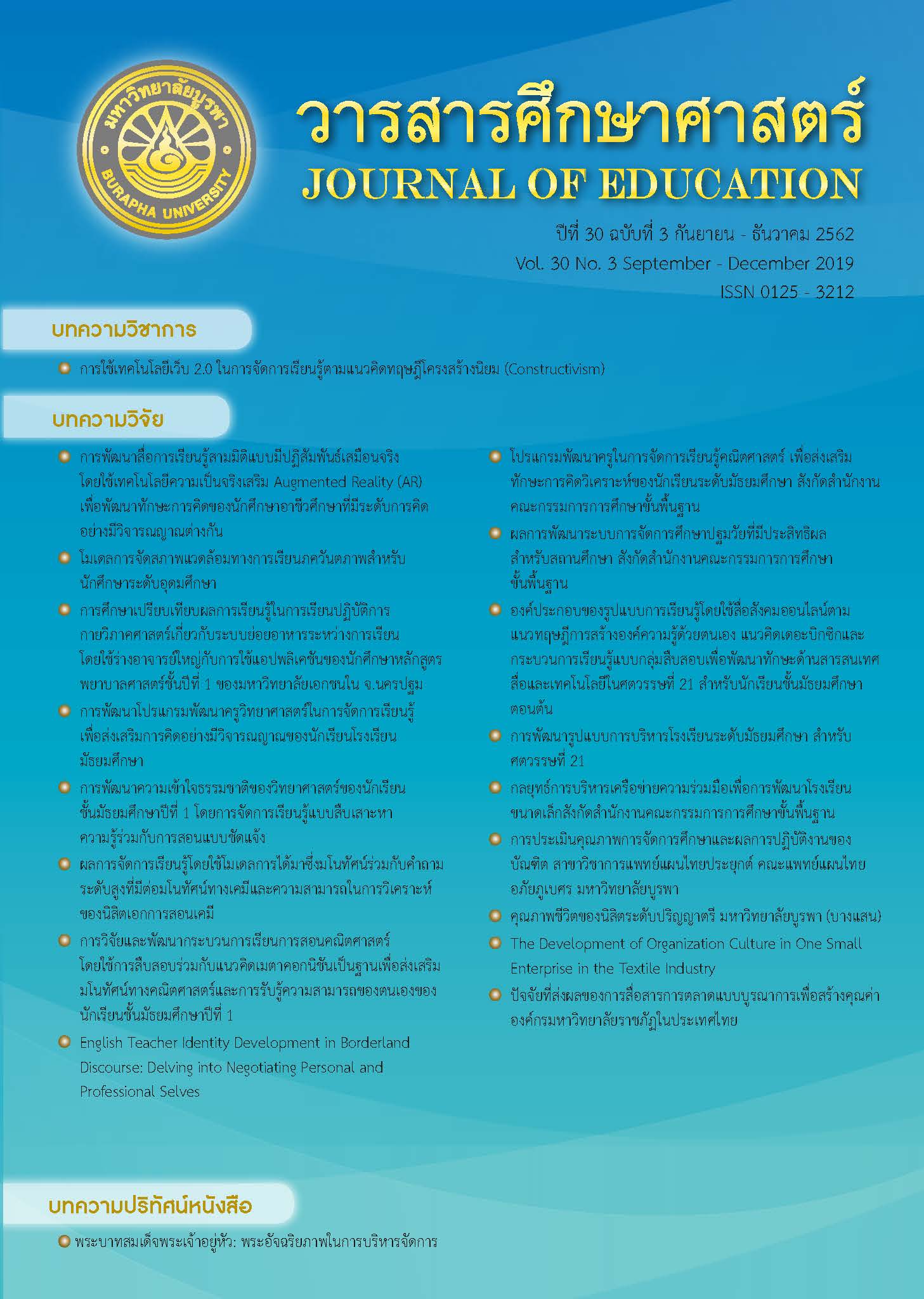การใช้เทคโนโลยีเว็บ 2.0 ในการจัดการเรียนรู้ตามแนวคิดทฤษฎีโครงสร้างนิยม (Constructivism)
คำสำคัญ:
เทคโนโลยีเว็บ 2.0, การเรียนรู้, ทฤษฎีการเรียนรู้, ทฤษฎีโครงสร้างนิยมบทคัดย่อ
ที่ผ่านมานวัตกรรมและเทคโนโลยีเกิดขึ้นเพื่อตอบสนองความต้องการของมนุษย์ได้เป็นการเฉพาะด้าน เช่น นวัตกรรมและเทคโนโลยีการเกษตร นวัตกรรมและเทคโนโลยีการแพทย์ เป็นต้น ในปัจจุบันสมรรถนะและศักยภาพของเทคโนโลยีดิจิทัลและการสื่อสาร หรือเทคโนโลยีเว็บ 2.0 และเทคโนโลยีที่เกี่ยวเนื่องได้ถูกนำมาใช้ได้หลากหลายและเชื่อมต่อถึงกันได้ (Coccia, 2019) ในด้านการเรียนรู้โดยเฉพาะการเรียนรู้ตามแนวคิดทฤษฎีโครงสร้างนิยมด้วยเทคโนโลยีเว็บ 2.0 สามารถพัฒนาการสร้างองค์ความรู้และความคิดของผู้เรียนมากขึ้นกว่าเดิม เป็นองค์ประกอบสำคัญของสภาพแวดล้อมการเรียนรู้แบบการสร้างความรู้แนวสังคม (Social constructivism) (Cochrane, & Flitta, 2013) ที่ก่อให้เกิดพัฒนาการทั้งด้านสติปัญญา อารมณ์ และสังคมอีกด้วย (Dang, 2018) นอกจากนี้การเรียนรู้โดยการร่วมมือกัน (Collaborative Learning) ของผู้เรียนทำให้เกิดการเรียนรู้แบบผู้เรียนเป็นศูนย์กลาง (Ge, Turk, & Hung, 2019; Bai, Li, & Chen, 2018, March) เทคโนโลยีเว็บ 2.0 นอกจากช่วยสร้างองค์ความรู้และปัญญาให้กับผู้เรียนตามความสนใจเฉพาะบุคคลแล้ว ยังเป็นเครื่องมือสร้างองค์ความรู้และปัญญาร่วมกันในสังคมได้อย่างมีประสิทธิภาพที่นำไปสู่การพัฒนาสังคมอย่างยั่งยืนได้
เอกสารอ้างอิง
& Semantic Technology, 3(1), 1-10.
Bai, J., Li, H., & Chen, J. (2018, March). Research on Constructivism-based Collaborative Learning Mode. In 2nd International Conference on
Economics and Management, Education, Humanities and Social Sciences (EMEHSS 2018). Atlantis Press.
Bassani, P. B. S., & Barbosa, D. N. F. (2018). Experiences with web 2.0 in school settings: A framework to foster educational practices based on a
personal learning environment perspective. Educação em Revista, 34.
Can, İ., Gelmez-Burakgazi, S., & Celik, I. (2019). An investigation of uses and gratifications for using WEB 2.0 technologies in teaching and
learning processes. International Online Journal of Education and Teaching, 6(1), 88-102.
Chatti, M. A., & Muslim, A. (2019). The PERLA Framework: Blending Personalization and Learning Analytics. International Review of Research in
Open and Distributed Learning, 20(1).
Coccia, M. (2019). A theory of classification and evolution of technologies within a Generalised Darwinism. Technology Analysis & Strategic
Management, 31(5), 517-531.
Cochrane, T., & Flitta, I. (2013). Mobile web 2.0 integration. International Journal of Handheld Computing Research (IJHCR), 4(3), 1-18.
Firat, E. A., & Köksal, M. S. (2019). Effects of instruction supported by web 2.0 tools on prospective teachers' biotechnology literacy. Computers &
Education.
Ge, X., Turk, M., & Hung, W. (2019). Revisiting cognitive tools from a social and motivational perspective. Australasian Journal of Educational
Technology, 35(2).
Gee, J. P., & Esteban-Guitart, M. (2019). Designing for Deep Learning in the Context of Digital and Social Media. Comunicar: Media Education
Research Journal, 27(58), 9-17.
Goldie, J. G. S. (2016). Connectivism: A knowledge learning theory for the digital age? Medical teacher, 38(10), 1064-1069.
Maseleno, A., Sabani, N., Huda, M., Ahmad, R., Jasmi, K. A., & Basiron, B. (2018). Demystifying learning analytics in personalised learning.
International Journal of Engineering & Technology, 7(3), 1124-1129.
Mattar, J. (2018). Constructivism and connectivism in education technology: Active, situated, authentic, experiential, and anchored learning.
RIED. Revista Iberoamericana de Educación a Distancia, 21(2), 201-217.
Melzer, P. (2019). A Conceptual Framework for Task and Tool Personalisation in IS Education. In A Conceptual Framework for Personalised
Learning (pp. 47-76): Springer.
Ohei, K. N., & Brink, R. (2019). Web 3.0 and Web 2.0 Technologies in Higher Educational Institute: Methodological Concept towards a Framework
Development for Adoption.
Pileggi, S. F., Fernandez-Llatas, C., & Traver, V. (2012). When the social meets the semantic: Social semantic web or web 2.5. In: Molecular
Diversity Preservation International.
Rahimi, E., Van den Berg, J., & Veen, W. (2012). Designing and implementing PLEs in a secondary school using Web 2. 0 tool. In The Personal
Learning Envrionment (PLE) Conference, Melbourne, Australia, 12-13 July, 2012. Public Knowledge Project.
You, X., Zhang, C., Tan, X., Jin, S., & Wu, H. (2019). AI for 5G: Research directions and paradigms. Science China Information Sciences, 62(2),
21301.
ดาวน์โหลด
เผยแพร่แล้ว
รูปแบบการอ้างอิง
ฉบับ
ประเภทบทความ
สัญญาอนุญาต
บทความทุกบทความเป็นลิขสิทธิ์ของวารสารศึกษาศาสตร์ มหาวิทยาลัยบูรพา



